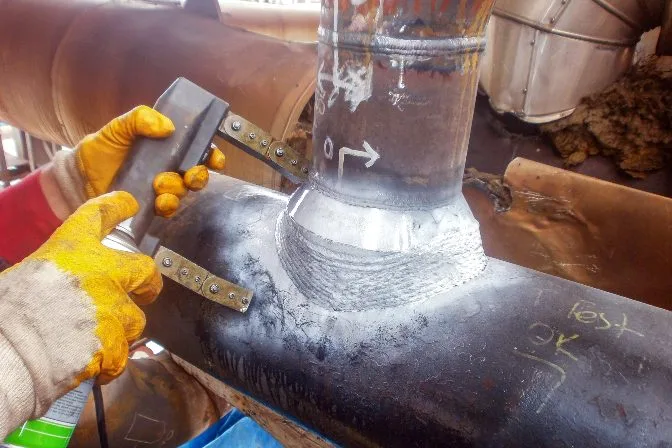A Detailed Introduction of Container Welding Evaluation Standards and Methodologies for Improved Weld Quality and Performance
The value of welding evaluation requirements in the manufacturing of tanks can not be overemphasized, as they offer as the foundation for making sure weld stability and functional integrity. Various assessment techniques, including aesthetic analyses and progressed non-destructive testing methods, are critical in recognizing possible defects that might compromise efficiency.
Significance of Welding Examination Specifications

Welding inspection criteria incorporate an array of requirements, consisting of material requirements, welding procedures, and certifications of personnel associated with the welding process. By applying these requirements, companies can systematically determine and fix prospective issues, thereby minimizing the likelihood of expensive repair services or catastrophic failures. Strenuous inspection practices promote a society of liability and accuracy, encouraging welders to preserve high levels of workmanship.

Usual Welding Examination Strategies


Ultrasonic Testing (UT) is another common strategy, making use of high-frequency acoustic waves to discover internal problems that may not show up on the surface. This technique is particularly reliable for recognizing gaps or inclusions within the weld metal. Magnetic Fragment Evaluating (MT) is additionally commonly used, especially for ferromagnetic products, as it exposes surface area and near-surface flaws with the application of electromagnetic fields and ferrous fragments.
Furthermore, Fluid Penetrant Testing (PT) detects surface-breaking problems by applying a penetrant to the weld and then utilizing a developer to extract the penetrant. Each of these methods adds to a thorough assessment technique, making certain that welds fulfill the rigorous quality criteria required in container building.
Regulatory Requirements and Compliance
Governing standards and conformity are important parts in guaranteeing the safety and security and dependability of welded structures in container building and construction - Tank Welding Inspection. These criteria serve to establish minimum demands for product residential properties, welding procedures, and assessment practices, consequently reducing the danger of architectural failings and improving general performance
Trick organizations, such as the American Culture of Mechanical Engineers (ASME) and the American Welding Society (AWS), give standards that are extensively taken on in the sector. Compliance with these standards not just makes sure adherence to finest techniques but likewise fulfills lawful and contractual responsibilities, protecting the rate of interests of stakeholders.
Regulative bodies commonly mandate adherence to details codes, such as ASME Code Section IX for welding certifications and API 650 for bonded containers. These codes outline needs for welding techniques, qualifications of workers, and testing techniques to validate weld honesty.
Regular audits and examinations are critical to keeping compliance, as they help recognize discrepancies from established requirements. Non-compliance can lead to considerable charges, job hold-ups, and security dangers. Therefore, a durable understanding of regulative requirements and a commitment to compliance are critical in achieving top quality and resilient welded tank structures.
Non-Destructive Testing Approaches
Just how can the honesty of bonded structures be guaranteed without creating damages? Non-destructive testing (NDT) techniques offer Full Article a robust solution, allowing examiners to assess weld top quality without compromising the product - Tank Welding Inspection. Amongst one of the most typical NDT techniques are ultrasonic screening (UT), radiographic screening (RT), magnetic bit testing (MT), and color penetrant screening (PT)
Radiographic testing entails passing X-rays or gamma rays through the weld, developing pictures that disclose structural issues such as fractures or voids. This approach is important for assessing the stability of intricate welds.
Magnetic bit screening is fit for ferromagnetic products, where magnetic fields disclose surface and near-surface stoppages. Dye penetrant screening utilizes a fluid dye to highlight surface-breaking problems, making it an effective technique for non-porous materials.
Each of these NDT approaches has distinct benefits, allowing for comprehensive evaluations customized to particular products and welding procedures. By executing these strategies, industries can ensure the dependability and safety and security of welded structures, inevitably improving general performance.
Enhancing Weld Quality Via Inspection
Reliable inspection plays an important duty in boosting weld quality, offering as a vital checkpoint in the construction procedure. By determining possible issues early, examinations mitigate the risk of jeopardized architectural stability and make certain conformity with industry standards. Employing a combination of visual assessments, non-destructive screening (NDT) techniques, and mechanical evaluations, examiners can spot concerns such as porosity, splits, and insufficient fusion.
Implementing a robust evaluation protocol not only improves the overall quality of welds but also fosters a culture of responsibility amongst welders and makers. Normal training and certification of inspection personnel make certain that they are outfitted with the essential abilities to identify and attend to prospective problems effectively. This aggressive strategy reduces rework and associated costs, eventually adding to project effectiveness.
In addition, extensive documentation of examination searchings for gives beneficial understandings into recurring concerns, assisting in constant improvement in welding techniques. By leveraging innovative innovations, such as automated ultrasonic testing find more info or electronic radiography, weld high quality can be enhanced via a lot more accurate evaluations. To conclude, an extensive inspection process is indispensable in attaining premium welds, making certain safety, integrity, and durability in container construction.
Conclusion
To conclude, the execution of extensive tank welding examination requirements and techniques is vital for ensuring weld honesty and performance. By using a mix of visual examinations, non-destructive testing approaches, and adherence to regulatory criteria, organizations can successfully identify and alleviate possible problems. Cultivating visit homepage a society of accountability amongst welders better improves the top quality of welding processes. Ultimately, these techniques add to minimized architectural failures, lower fixing costs, and enhanced functional efficiency within the industry.